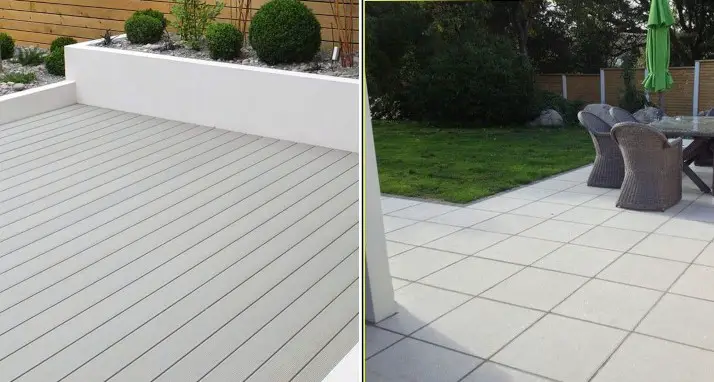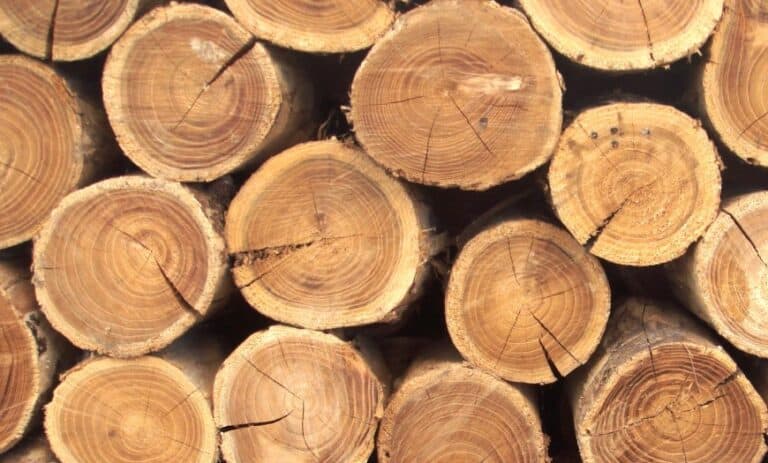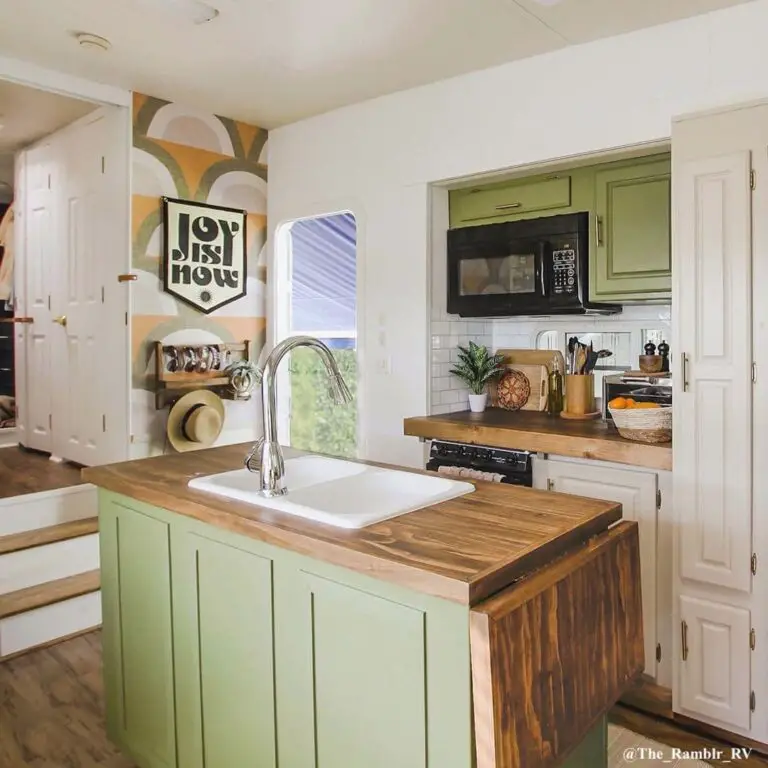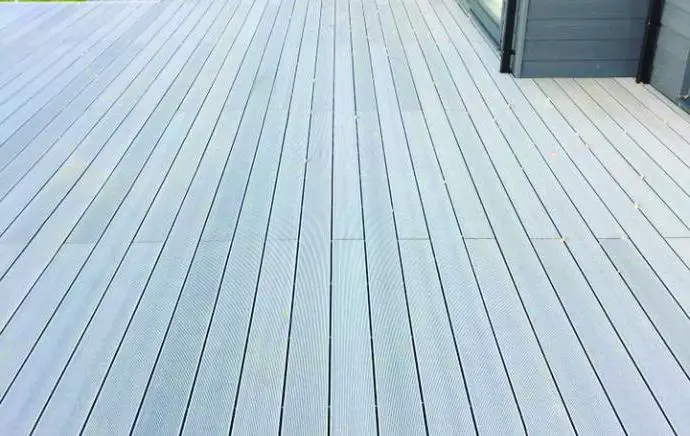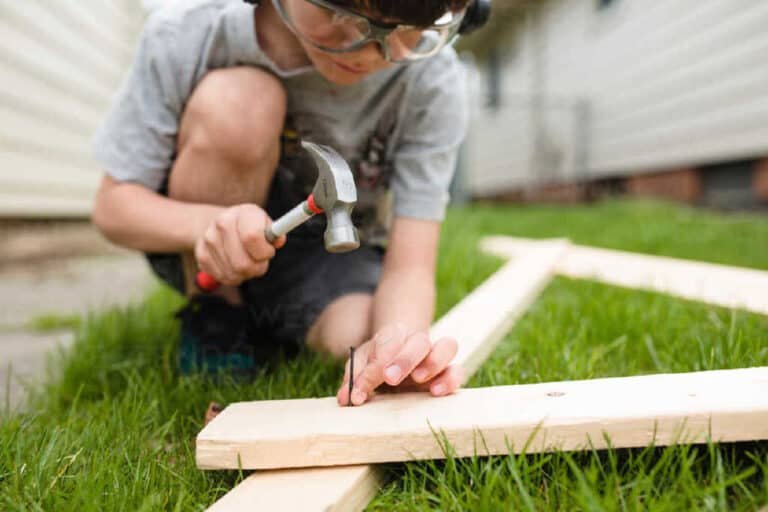Non-Slip Composite Decking Guide: How to Make Your Deck Anti-Slippery

Composite decking is a popular choice for homeowners because of its durability and low maintenance. Composite decking is available in a variety of colors and styles, so you can find the perfect deck for your home.
One downside to composite decking is that it does not hold up well to heavy rain or snow. When wet, most composite decking is more slippery than wood decking. This can be dangerous, especially if you have children or pets who like to run around outside.
In this article, we will explain what is causing your decking to be slippery and how to make your deck anti-slip. We will also look for alternatives to composite decking that can provide better water resistance in order to prevent slippery conditions.
Understanding Composite Decking and Its Advantages
Composite decking is a modern alternative to traditional wood decking and is made from a blend of recycled materials, including wood fibers and plastic. This decking material has gained immense popularity in recent years due to its durability, low maintenance, and eco-friendliness.
One of the main advantages of composite decking is its ability to withstand harsh weather conditions. In contrast to wood decking, composite decking does not rot, warp, or splinter, and it is not vulnerable to insect infestation. This makes it ideal for use in areas with high humidity, heavy rainfall, or extreme temperatures.
Another benefit of composite decking is its low maintenance requirements. Unlike wood decking, which requires periodic sealing, staining, and painting, composite decking only requires occasional cleaning with soap and water to keep it looking its best. This means that homeowners can spend more time enjoying their outdoor living spaces and less time maintaining them.
In addition to its durability and low maintenance requirements, composite decking is also environmentally friendly. Many manufacturers use recycled materials to create their composite decking products, reducing the amount of waste that ends up in landfills. Additionally, composite decking does not require the use of harmful chemicals or preservatives, which can be harmful to the environment.
Another advantage of composite decking is its versatility. Composite decking comes in a variety of colors and styles, allowing homeowners to customize their outdoor living spaces to their liking. Additionally, composite decking can be used for a variety of applications, including decking, railing, and fencing.
What Makes Composite Decking Slippery?
Composite decking is often chosen due to its durability and low-maintenance qualities, but one potential downside is that it can be slippery. This may be a concern if you have a lot of activities or if you entertain frequently and want your deck to be safe for guests.
Before we can begin to examine possible solutions for your slippery deck’s problems, it’s crucial that you first have a solid understanding of why your deck is slippery in the first place.
There are several factors that can cause your deck to become more slippery. These causes may even interact with one another to worsen the problem and make your deck even more difficult to play.
1. Debris
Debris that accumulates on the surface of the decking can cause an issue. This debris may include dirt, pollen, leaves, twigs, and small branches. When the deck gets wet, the debris becomes slick and causes people to slip and fall.
All of that debris is a water trap because it stores moisture and presses it up against the deck’s wood. This dampness creates an ideal environment for the growth of fungi, mildew, algae, and even moss.
2. Rainwater
Rainwater can make composite decking slick. This type of decking is made of wood fibers and plastic. Wood fibers soak up the water and cause the plastic to become slick. This can make it dangerous to walk on the deck when it is wet.
3. Finish material
Another factor is the type of finish that’s used on the decking. Some finishes are more slip-resistant than others, so you may want to ask your contractor about this when you’re choosing materials.
4. Texture of the decking
Finally, the texture of the decking can also affect the slipperyness and grip of the surface. Smooth surfaces are more likely to be slick than those with a rough texture.
How to Prevent a Deck From Getting Slippery
One of the worst things that can happen while you are enjoying a day out on your deck is for it to become slippery and dangerous. There are a few things you can do to prevent your deck from getting slippery.
1. Keep It Clean.
Sweep or hose off any debris regularly. You may also want to consider using a cover to protect your deck from rain and snow. If you already have a composite deck, be sure to keep it clean and dry during bad weather conditions.
2. Use Sealant.
You can prevent rainwater from becoming slippery by applying a sealant. A sealant will help to keep the water from getting to the wood fibers and making the decking slick and greasy.
3. Drainage System
You might have discovered that there is a space of a few millimeters between each of the decking boards that you have. These spaces should be large enough to allow the boards to expand and contract, but they should also be large enough to let water and moisture escape. This will prevent water and moisture from pooling on your deck and allowing anything to develop there.
Is there any “100% non-slip decking”?
Before we go any further, let’s be clear: there is no such thing as 100% non-slip decking. Any company that sells its products as slip-free decking is literally not telling you the truth, despite how much we’d love to believe there is such a thing.
Slip-free decking simply does not exist, despite how much we’d love to say it does.
However, when it comes to minimizing the risk of slips and falls, there are some products on the market that are less slippery compared to others.
Some manufacturers were selling “quick-drying decking” boards that have been meticulously manufactured to absorb less than 1.2 percent water, making them as water-resistant as they possibly can be. These characteristics ensure that your decking is as effective as it can be at repelling water.
How to Increase Decking’s Grip
While decking is oftentimes thought of as a slip-resistant material, it can become slick in wet or icy conditions. Here are a few ways to make your decking non-slip by increasing its grip:
1. Add texture to the surface of your decking.
To prevent slips, add a textured surface to the decking. This can be done with a stamp or roller that applies a rough pattern to the decking. The manufacturer also adds a non-slip additive to the composite material during manufacturing.
2. Install anti-slip strips or pads.
To prevent slips and falls, you can install anti-slip strips or pads on your deck. These products are available at most hardware stores. They are easy to install and will help keep you safe while enjoying your deck. Be sure to read the manufacturer’s instructions carefully before installing them, as they may vary depending on the product.
You may install specific antislips for your furniture legs. This will protect your composite deck from furniture or from frequently moving your furniture.
3. Spread sand or grit.
You may add material to the surface of your deck to reduce its slipperiness. One simple way to do this is to spread sand or grit over the decking. This creates an extra grip and helps keep people safe.
Use a shovel to spread the sand or grit, or you can use a leaf blower. Be sure to sweep up any excess material after you are done.
4. Install a skirt.
One way to prevent slips is to install a skirt around the edge of the deck. The skirt prevents people from slipping on the edge of the deck and also hides any unsightly areas. It also prevents water from accumulating on your deck.
5. Add a coating of anti-skid paint or sealant.
One way to prevent slips and falls on your deck is to add a coating of anti-skid paint. This special paint is designed to increase traction, making it less likely for someone to slip on wet or icy surfaces. These coatings specialized for decking are available at most hardware stores.
6. Install a rubberized underlayment on your decking.
One way to prevent slips and falls on a composite deck is to use a rubberized underlayment. This material creates a surface that is less likely to cause slips and helps reduce noise levels.
7. Install a patio cover.
To help prevent slips and falls, consider installing a patio cover over your deck. A patio cover will provide shade and shelter from the rain. It keeps the surface of your deck dry, making it safer to use.
Cost Analysis: Non-Slip Composite Decking vs. Other Decking Materials
When it comes to selecting a decking material, cost is often a significant factor to consider. While traditional wood decking may initially appear to be the most affordable option, it is important to take into account the long-term costs and maintenance requirements. This is where non-slip composite decking comes in as an alternative that can actually save you money in the long run.
Non-slip composite decking has a higher upfront cost than traditional wood decking, but it offers numerous advantages that make it a better long-term investment. Firstly, composite decking does not require the same level of maintenance as wood decking, which can save homeowners significant amounts of money over time. Traditional wood decking requires frequent sealing, staining, and repainting, all of which can be costly and time-consuming. With non-slip composite decking, all that is required is occasional cleaning with soap and water, making it a low-maintenance and cost-effective option.
Another factor to consider is the durability of the decking material. Non-slip composite decking is highly durable and can withstand harsh weather conditions and heavy foot traffic without showing signs of wear and tear. Traditional wood decking, on the other hand, can rot, warp, or splinter over time, requiring expensive repairs or replacement.
In terms of safety, non-slip composite decking is a much better option than traditional wood decking. Its non-slip surface provides added traction and reduces the risk of slips and falls, making it an ideal choice for families with children or seniors.
When compared to other decking materials, non-slip composite decking is still a cost-effective option. While the initial cost may be higher than some materials, such as pressure-treated wood or cedar, the long-term savings and low maintenance requirements make it a smart investment. Other materials, such as PVC decking, may have a lower upfront cost, but they may not be as durable or as eco-friendly as non-slip composite decking.
Composite Decking Alternative That Is Waterproof
Composite decking is made of a blend of wood and plastic and is a popular choice for decks. One downside to composite decking, however, is that it is not water-resistant. It can be susceptible to water damage if not properly sealed.
So, is there truly waterproof composite decking available on the market? The straightforward answer is no. Composite decking can not be 100% waterproof or 100% water-resistant.
So if you are looking for more durable decking that is also waterproof, then consider the below decking alternatives.
1. PVC decking
PVC decking is the best choice for those who want a synthetic deck that is waterproof and low-maintenance.
PVC decking is made from a plastic called polyvinyl chloride, which is durable and resistant to weather and pests. There are a few different brands that you should be familiar with, despite the fact that there are not as many possibilities available as there are with composite decking.
PVC decking is available in a variety of colors and styles, and it does not require painting or staining.
2. Aluminum Decking
If you are looking for a durable and affordable decking material, aluminum may be the perfect option for you. When it comes to strength, aluminum decking is not only superior to PVC decking, but also to composite decking and even traditional wood decking.
Aluminum is a lightweight metal that is corrosion- and water-resistant, making it ideal for outdoor use. In addition, aluminum decking is relatively inexpensive compared to other materials such as wood or composite.
One downside to aluminum decking is that it can dent and scratch more easily. However, a good coat of paint will protect your deck and help to hide any minor dents or scratches.
3. Vinyl decking
One lesser-known type of decking material is vinyl. Vinyl decking has been growing in popularity in recent years, due to its low cost, easy installation, and durability.
One of the main benefits of vinyl decking is that it is extremely durable. Vinyl decks are resistant to weathering, fading, and staining, making them a great choice for homeowners who want a low-maintenance deck.
Vinyl decks also come in a variety of colors and styles, so you can find one that will perfectly match your home’s exterior.
4. Fiberglass decking
Fiberglass decking is a waterproof alternative to traditional wood or composite decking. It is made of fiberglass reinforced plastic (FRP) that is resistant to moisture, chemicals, and UV radiation. It can also be designed with a non-slip surface texture for added safety.
5. Engineered wood decking
Engineered wood decking is a composite material that combines wood fibers with a waterproof resin binder. It is designed to resist water and moisture, as well as insects and decay. It can be made to look like traditional wood decking, but with added durability and water resistance.
Conclusion
In conclusion, while composite decking is a great option for those looking for a non-slip surface, the fact is that composite decking can become slippery when wet.
This is because it is made of wood fibers, plastic, and artificial bonding agents. Not all composite decking is created equal, so be sure to ask questions and read reviews before making a purchase.
There are some measures you can take to make your composite decking less slippery. Adding texture to the surface, installing anti-slip strips, and spreading sand or grit above it
There is now “quick-drying” composite decking available that is specifically designed to prevent water damage. So you have a choice based on your needs.

